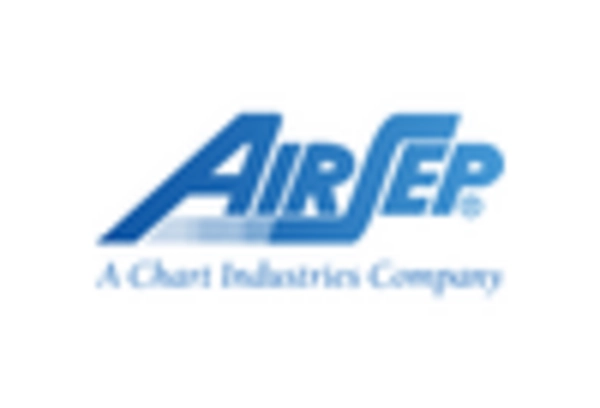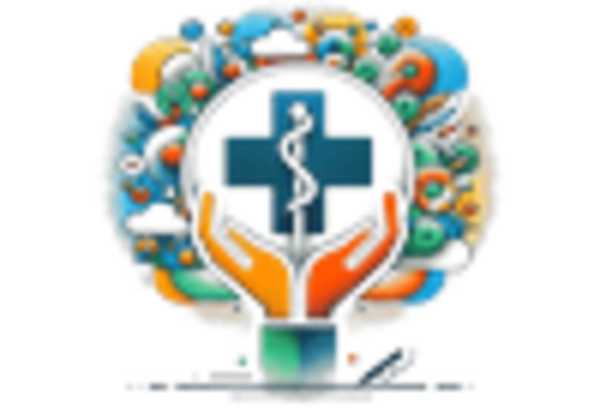Aging Population
The aging population in South Korea is a critical driver for the oxygen therapy-equipment market. As the demographic shifts towards an older age group, the prevalence of chronic respiratory diseases, such as COPD and asthma, is likely to increase. According to recent statistics, approximately 15% of the elderly population suffers from these conditions, necessitating the use of oxygen therapy. This growing demand for oxygen therapy solutions is expected to propel market growth, as healthcare providers seek to improve the quality of life for older patients. Furthermore, the increasing life expectancy in South Korea, which stands at around 83 years, suggests a sustained need for effective respiratory care solutions. Consequently, the oxygen therapy-equipment market is poised to expand significantly in response to the healthcare needs of this demographic.
Rising Air Pollution
Rising air pollution levels in South Korea are emerging as a significant driver for the oxygen therapy-equipment market. Urban areas, particularly Seoul, experience high concentrations of particulate matter and other pollutants, which adversely affect respiratory health. Reports indicate that air quality in South Korea has deteriorated, with PM2.5 levels often exceeding safe limits. This environmental concern is likely to lead to an increase in respiratory ailments among the population, thereby boosting the demand for oxygen therapy equipment. As individuals seek to mitigate the effects of pollution on their health, the market for oxygen therapy solutions is expected to grow. The government’s focus on improving air quality may also indirectly support the oxygen therapy-equipment market by raising awareness about respiratory health and the importance of oxygen therapy.
Technological Innovations
Technological innovations in the healthcare sector are driving advancements in the oxygen therapy-equipment market. The introduction of portable oxygen concentrators and advanced delivery systems has revolutionized the way oxygen therapy is administered. These innovations not only enhance patient mobility but also improve the overall efficiency of oxygen delivery. In South Korea, the market for portable oxygen devices is projected to grow at a CAGR of 8% over the next five years, reflecting the increasing preference for user-friendly and efficient solutions. Additionally, the integration of smart technology in oxygen therapy devices allows for real-time monitoring and personalized treatment plans, further propelling market growth. As healthcare providers and patients alike embrace these advancements, the oxygen therapy-equipment market is likely to witness substantial expansion.
Increased Healthcare Expenditure
Increased healthcare expenditure in South Korea is a pivotal driver for the oxygen therapy-equipment market. The government has been investing significantly in healthcare infrastructure, aiming to enhance the quality of care and accessibility for patients. Recent data indicates that healthcare spending in South Korea has risen to approximately 8.1% of GDP, reflecting a commitment to improving health services. This increase in funding is likely to facilitate the procurement of advanced oxygen therapy equipment, as hospitals and clinics seek to provide better respiratory care. Moreover, the growing trend of health insurance coverage for oxygen therapy treatments is expected to further stimulate market growth. As financial resources become more readily available, the oxygen therapy-equipment market is positioned for robust development.
Rising Awareness of Respiratory Health
Rising awareness of respiratory health among the South Korean population is significantly influencing the oxygen therapy-equipment market. Public health campaigns and educational initiatives have been instrumental in informing individuals about the importance of respiratory care and the benefits of oxygen therapy. As awareness increases, more patients are likely to seek treatment for respiratory conditions, leading to a higher demand for oxygen therapy solutions. Additionally, healthcare professionals are becoming more proactive in diagnosing and treating respiratory diseases, further driving the market. The emphasis on preventive care and early intervention is expected to result in a growing patient base for oxygen therapy, thereby enhancing the overall market landscape. This trend indicates a promising future for the oxygen therapy-equipment market as it aligns with the evolving healthcare priorities in South Korea.

















Leave a Comment